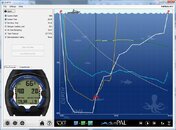Scubaru_Steve
Contributor
So I bought a Suunto Cobra 3 a few months ago, absolutely love this computer.
Well I am updating my paper dive logs and am not sure what is the best way to approach this.
On some of my dives (just the ocean dives) my depth is consistant for the most part of the entire dive as the ocean floor is pretty flat.
However when I dive Dutch Springs (Quarry in Pa for those unsure), I find I have a lot of ups and downs based on the location of each point of interest.
So the Cobra 3 gives me both a max depth and an average depth. I wasn't sure if I should utilize the average depth to calculate my dive profile on my dive logs. Sure the Cobra 3 keeps track of all of this and is digitally loaded on my computer, but I like having a hard copy of everything for safe keeping and signatures to allow me to advance.
Well I am updating my paper dive logs and am not sure what is the best way to approach this.
On some of my dives (just the ocean dives) my depth is consistant for the most part of the entire dive as the ocean floor is pretty flat.
However when I dive Dutch Springs (Quarry in Pa for those unsure), I find I have a lot of ups and downs based on the location of each point of interest.
So the Cobra 3 gives me both a max depth and an average depth. I wasn't sure if I should utilize the average depth to calculate my dive profile on my dive logs. Sure the Cobra 3 keeps track of all of this and is digitally loaded on my computer, but I like having a hard copy of everything for safe keeping and signatures to allow me to advance.





